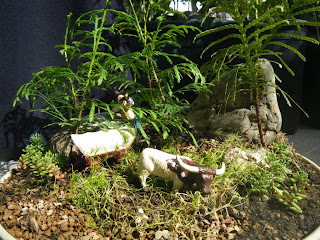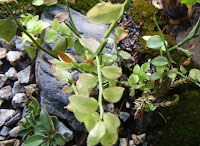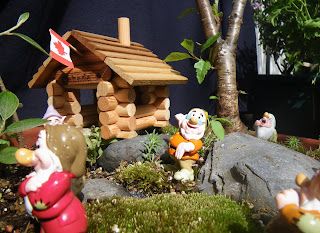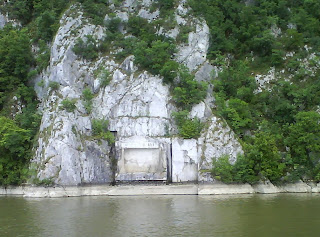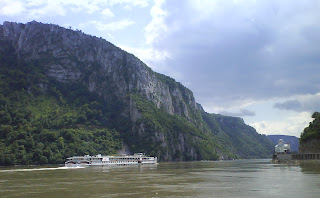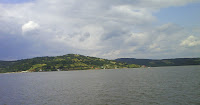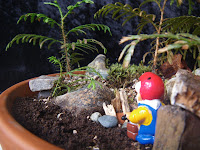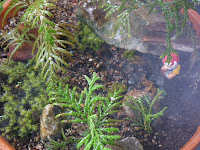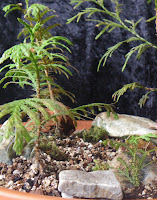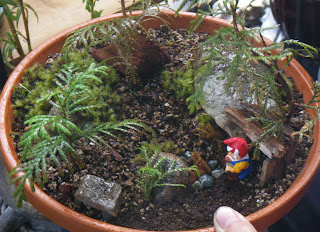These days was very hot here in Vancouver, and it makes me think of extremely hot summer days from my native country,
Romania.
I will blog about some reasons that make me to miss my charming native places full of history where I spent many years of life.

It is an area of wild and somehow mystical beauty situated on the "Old Continent", between the Lower Danube Valley and the Balkan foothills, between Carpathians Mountains and Black Sea, on
Zamolxis land. The people who lived on this blessed land had Dacian-Roman origins. Herodotus called them "the fairest and most courageous of men" because they believed in the immortality of the soul and were not afraid to die.

My heritage arises from ancestral times and combines The Dacian-Thracian spirituality with the amazing Roman culture. Carved stone tools and cave paintings evidenced that people inhabited Romanian land since the Paleolithic. In 3.000 B.C. the Thracian tribes of Indo-European origin, occupied the actual Romanian territory. The Greeks called them Getae, and the Romans - Dacians.
Between 82 - 44 B.C. , Dacian king
Burebista created a powerful Dacian kingdom. After his death, the Dacian kingdom was split into five smaller states. Between 87-106 A.D., the king of Dacia
Decebalus “The Brave” reunited the core of Dacia and was fighting three wars against the Roman Empire. Between 101-106 A.D. Romans conquered and colonized Dacia, making it "Dacia Trajana", province of the Roman Empire, for almost 150 years, and the Dacians "adopted" the conqueror's language ... or maybe not.
I not intend to tell now the entire history of Romanian people, but I wish to tell you about the Mraconia Bay, situated near Orsova, within Dubova commune area, where after 2000 years, Decebal and Trajan stand again symbolically face to face.
The Danube River was immortalized by Johann Strauss in his famous "The Blue Danube", is the Europe's second longest river which surges through most of Central Europe, starting in Germany's Black Forest and flowing into the Black Sea.
On the Romanian side of the Danube River's, I admired last summer
a monumental sculpture of over 55 m high representing the head of the Dacian king Decebal.
Professor Josif Constantin Dragan was the person who initiated and financed this tallest sculpture in stone from Europe, which was carved between 1994-2004.
On the other side of the Danube river`s banks, on the Serbian side, lies the
“Tabula Traiana”, a Roman memorial plaque 4 meters in width and 1.75 meters in height, commemorating the completion of Roman Emperor Trajan's military road.
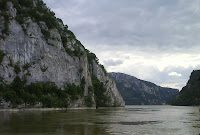
There is the place where Lusius, a Roman Leader crossed the Danube when invaded Dacia in 101.
The
Danube Gorge/ Clisura Dunarii lies between Romania in the north and Serbia in the south, and separates the southern
Carpathian Mountains from the northwestern foothills of the
Balkan Mountains.
The
Great Kazan Gorge/ Cazanele Mari is the most spectacular, where the river narrows to 150 m above and reaches a depth of up to 53 m. The gorge itself is a deep one with mountains on either side of the gorge towering at the time, with a stunning rocky panorama. The lush green landscape with cover the cliffs make the gorges look wild romantic.
On the
Little Kazan Gorge/ Cazanele Mici of the Danube has built an orthodox monastery named
Mraconia (dark water).
Over the years the monastery has been known under different names: the Monastery of the Danube Valley, the monastery of the Mracuna valley, the monastery of Ogradena-Veche, the monastery of Orsova .
The Great and Small Kazan Gorges/ Cazanele Mari si Mici (kazan means boiler), which ends with the last section, the
Orsova Valley, have a length of 19 km. On this route the grounds are beautiful and serene, and I think that this is the most lovely section along the Danube River.
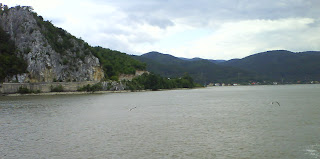
I explored those wonderful places last year when I took a Danube cruise around the section of Orsova - Mraconia Monastery and back to Orsova. The magic of the steep cliffs towering beside me made my trip a memorable experience of my life. In this trip I remembered how lucky are the people of these dreaming lands and I recovered a part of my ancestors history.
The Danube River is one of the most international river on the planet - it runs across or forms a part of the borders of : Germany, Austria, Slovakia, Hungary, Croatia, Serbia, Romania, Bulgaria, Ukraine. The beauty of Danube Gorge had inspired many poets and Herodotus called Danube River " The Greatest of all Rivers".
I miss The Danube Valley ...

If you don't have one already, buy a map first thing when you arrive at a destination or click picture to buy Romanian Travel Map now.

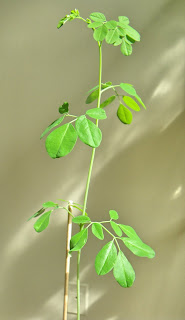 Today I made my first salad with fresh moringa leaves. My young Moringa / Malunggay / Sajina / Murungai seedlings, which are sitting in a corner of my house with full light, was growing very quickly and some of them became
Today I made my first salad with fresh moringa leaves. My young Moringa / Malunggay / Sajina / Murungai seedlings, which are sitting in a corner of my house with full light, was growing very quickly and some of them became 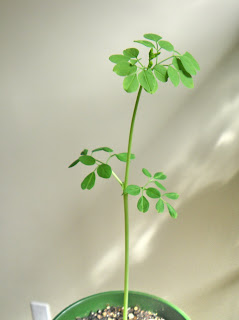

 I already learned about the great nutrition of Moringa leaves last months (BTW, until this winter I have never heard about this tree) Now I have my own Moringa plants but I need to learn how to use them. I browsed many cook books on the internet and I found many interesting recipes and how it is used in India, Mexic, Mauritius, Thailand, Philippines and other Asian and African countries. Many of these give details about how people from tropical countries used in cooking flowers from Moringa trees and I am very curious about their delicious taste. But I need to wait more weeks until I will taste their flowers...
I already learned about the great nutrition of Moringa leaves last months (BTW, until this winter I have never heard about this tree) Now I have my own Moringa plants but I need to learn how to use them. I browsed many cook books on the internet and I found many interesting recipes and how it is used in India, Mexic, Mauritius, Thailand, Philippines and other Asian and African countries. Many of these give details about how people from tropical countries used in cooking flowers from Moringa trees and I am very curious about their delicious taste. But I need to wait more weeks until I will taste their flowers...



